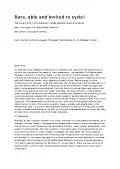-
Past ETC Papers

Browse, search and view papers from the past AET Conferences.
-
Members' Area

AET promotes networking and exchange of ideas, information and opportunities amongst members.
Conference Papers 2019
Dublin, Ireland
ETC Conference Papers 2019
Dare, able and invite to cycle!
Seminar
Day 2 (10 Oct 2019), Session 6, Cycling, 14:00 - 15:30
Status
Accepted, documents submitted
Submitted by / Abstract owner
Mark Van Hagen
Authors
Mark van Hagen
Bas Govers
Short abstract
Consulting agency Goudappel Coffeng is inspired by the pyramid of customer needs and translates the quality layers to cyclists using the same hierarchy of needs. These three layers for cycling are: dare to cycle, able to cycle and invite to cycle.
Abstract
Dare, able and invite to cycle!
Based on customer research the Netherlands Railways (NS) developed a conceptual model for the hierarchy of quality needs. This model is known as the pyramid of customer needs (Van Hagen, Peek & Kieft, 2000, Van Hagen, 2011). The power of this model is that it forms a lingua franca between different organisations within NS and outside NS. The base of the pyramid is about safety and reliability which is a prerequisite for a pleasant journey. When this fundament is robust enough, passengers experience the feeling of being in control. The next layers are formed by speed and ease which are core values for moving and are dissatisfiers, when this core service is performed well passengers are satisfied and feel appreciated. The layers in the top of the pyramid are comfort and experience and are key qualities when people are staying somewhere, the qualities in the top of the pyramid are satisfiers. When services in the top of the pyramid are well executed passengers are happy and experience a sense of freedom (Van Hagen & Van der Made, 2017). Benefit of this conceptual model is that organisations get on one page and better understand what customers want in different situations. Because the focus of different organisations - each with their own goals - are now forced to look at the outcome of service delivery seen through the eyes of the users of the service. This makes it possible to make decisions faster, better and more solid. NS uses this model for improving the quality of the service for customers and uses measurement systems which are linked to the pyramid of customer’s needs. This model has already been used outside the rail industry as well e.g. for policy development and realisation of new services for metros, busses and bicycles (CROW, 2014, OV magazine, 2016). Consulting agency Goudappel Coffeng is inspired by the pyramid of customer needs and translates the quality layers to cyclists using the same hierarchy of needs. These three layers for cycling are: dare to cycle, able to cycle and invite to cycle.
Dare to cycle is the fundament for cyclist to start cycling. This means that the bare minimum requirements for cycling have to be available like a basic infrastructure so cyclist have the opportunity to cycle even when other traffic uses the same infrastructure. Safety and reliability are the crucial elements for cyclists here. The cyclist is present in public space but not as important as other users and facilities for cyclists are shared with other users like pedestrians and cars.
Being able to cycle means that cycling is not only safe and reliable but also fast and easy: by using direct routes for cyclists, separate cycling lanes on the road and traffic lights for cyclist. The cyclist is one of the users of the public space, has more own space available but is still as important as the other users of the road.
When cyclists are invited the cyclist becomes the most prominent user and the environment to cycle must be very attractive. This can be realized by creating a dedicated infrastructure for cyclists only. Furthermore the cycle path must be wide, comfortable and attractive, so cycling becomes a nice experience. When cyclist feel invited, they experience that they have priority in traffic, are not bothered by other traffic and will enjoy cycling.
We believe that a definition of these three levels of cycling, based on the theory of the customer-experience in public transport, can help to categorize existing situations and ambitions for policy-makers. Further research is needed to find out what the impact will be on the market- share for cyclists: our hypothesis would be that in each level, dare, able and invite to cycle, the group of people that regularly cycle is larger and that the average distance will grow. In this way the market-share of cycling grows quadratic: more cyclists who cycle longer distances.
Programme committee
Planning for Sustainable Land Use and Transport
Documents:

Association For
European Transport
Forester House
Doctors Lane
Henley-in-Arden
Warwickshire, UK
B95 5AW
+44 (0) 15 64 793552
VAT number: 710 1866 64
Conference Supporters & Endorsers




Legal Entity
The Association for European Transport is registered as an Association ('vereniging') with the Chamber of Commerce for Haaglanden in The Netherlands under company number 27170096.
Built on Zenario




